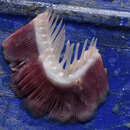en
names in breadcrumbs


Lernaeopodidae is a family of parasitic copepods.[1][2] The females are typically large and fleshy, and attach to the host permanently using a plug made of chitin called the bulla. The males cling on to the females using their antennae.[2] They parasitize both marine and freshwater fish. Some lernaeopodids, including Clavella and Salmincola, can have negative impacts on fish in aquaculture.[3]
The family contains the following genera:[1]
Lernaeopodidae is a family of parasitic copepods. The females are typically large and fleshy, and attach to the host permanently using a plug made of chitin called the bulla. The males cling on to the females using their antennae. They parasitize both marine and freshwater fish. Some lernaeopodids, including Clavella and Salmincola, can have negative impacts on fish in aquaculture.